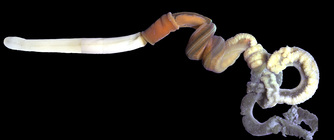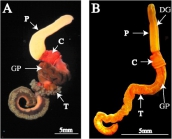Hemichordata taxon details
Saccoglossus bromophenolosus King, Giray & Kornfield, 1994
158484 (urn:lsid:marinespecies.org:taxname:158484)
accepted
Species
marine, fresh, terrestrial
King GM, Giray C, Kornfield I (1994). A new hemichordate, Saccoglossus bromophenolosus (Hemichordata: Enteropneusta: Harrimaniidae) from North America. Proceedings of the Biological Society of Washington 107: 383-390., available online at http://biostor.org/reference/81232 [details]
Swalla, B.J.; van der Land, J. (2024). Hemichordata World Database. Saccoglossus bromophenolosus King, Giray & Kornfield, 1994. Accessed at: https://www.marinespecies.org/hemichordata/aphia.php?p=taxdetails&id=158484 on 2024-05-03
Date
action
by
original description
King GM, Giray C, Kornfield I (1994). A new hemichordate, Saccoglossus bromophenolosus (Hemichordata: Enteropneusta: Harrimaniidae) from North America. Proceedings of the Biological Society of Washington 107: 383-390., available online at http://biostor.org/reference/81232 [details]
additional source van der Land, J. (ed). (2008). UNESCO-IOC Register of Marine Organisms (URMO). , available online at http://www.marinespecies.org/urmo/ [details]
additional source van der Land, J. (ed). (2008). UNESCO-IOC Register of Marine Organisms (URMO). , available online at http://www.marinespecies.org/urmo/ [details]
 Present
Present  Inaccurate
Inaccurate  Introduced: alien
Introduced: alien  Containing type locality
Containing type locality
From editor or global species database
Distribution This species has been found in the cold temperate northwest Atlantic and the cold temperate northeast Pacific. [details]Etymology The species name is derived from 2,4-dibromophenol and the Latin suffix -osus. [details]
Habitat They are benthic and live in burrows. They can be found in subtidal zones, or in silty sand in intertidal zones. [details]
Length S. bromophenolosus can attain a length up to 20cm. [details]
From other sources
Diet mucusciliary feeders, but also swallow a considerable amount of sand and presumably obtain nourishment from detritus ingested at the same time [details]Reproduction sexes are separate but may be indistinguishable externally; fertilization is external (dispersed in water) [details]



